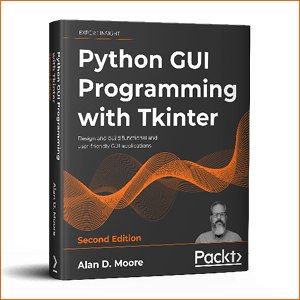Customer Services
Copyright © 2025 Desertcart Holdings Limited
Desert Online General Trading LLC
Dubai, United Arab Emirates


Python GUI Programming with Tkinter: Design and build functional and user-friendly GUI applications, 2nd Edition






B**.
Massive Improvement from the first edition
The second edition spends more time breaking you into GUI programming. The second edition does not simply add a few chapters with new stuff. A lot of effort has gone into the second edition.Before I say why I like the second edition enough to give it 5 stars, I will say why the first edition would only get a 1 star from me. The first edition jumps straight into Object Oriented Programming which is way to hard if you are not used to it. I personally write smaller scripts and dont have the time to learn that on top of GUI programming. At this point I put the first edition down and struggled to get into it again.This is where the second edition of the book really helps. You start off by writing a whole application from start to finish with no OOP. The example is almost exactly what I needed to convert my python script (it generates a program from a CNC machine) into a GUI. The language of the book is changed to make OOP easier to understand and that is where I am currently at.I will probably update my review once I work through the book, however, my program is complete and I don't think I could have done it without this book. I can't imagine how a third edition could improve on this.
S**N
As far as I can see one of the most up-to-date information on tkinter GUI programming in python 3.9
The media could not be loaded. Well there's basic information to cover any needs from starting out to professional use of tkinter.
C**G
Detailed walkthrough of tkinter and its applications
The author did an excellent job structuring this book. It covers how to get started, how to plan the design of the GUI, utilisations of classes, and many code and visual optimisations to improve the overall performance of the tkinter GUI. The level of detail is impressive and quite welcomed.As admitted by the author, tkinter has been around for some time and there are various other toolkits. Nevertheless, its still very much in use and relatively straightforward to implement - with the help of a solid reference like this book.A recommended reference for building Python GUIs with an established toolkit.
N**S
A proper grown up book
This book get straight to the heart of the matter. No pussy footing about with mickey mouse examples. Really useful if you have a serious interface to write.
D**T
For anyone wanting to learn how to develop GUIs using Python, this book is a must.
As a user of Python for data science this book was interesting from the point of view of learning how to use Python to create GUI applications.The author (Alan Moore) does a good job in presenting a lot! (600+ pages) of content. Across 16 chapters, starting with an introduction in which installation, IDLE, and the ubiquitous "Hello World" is implemented, the book takes the reader through basic form controls, menus, styles and themes, and a very useful chapter on packaging and deployment (handily for both Mac and Windows). This ordering of chapters is spot on as it gradually builds the readers knowledge. There is also a useful short summary at the end of each chapter, but no “test your knowledge” questions. The book is written in a clear style so it is easy to follow. At first glance, some chapters do feel ever so slightly out of place (e.g. “Improving Data Storage with SQL”, “Connecting to the Cloud”) but dig deeper and you see that they are actually quite usefulFor anyone wanting to learn how to develop GUIs using Python, this book is a must.
J**
Must Have for Tkinter
I purchased this book in order to learn more about GUI use and Tkinter. I didn't realize the book is over 600 pages. It starts out extremely simple and gets you going quickly while simultaneously teaching you in an understandable way. I'm only halfway through but so far, it's an awesome book. Goes over everything in great depth and is basically my new Tkinter offline encyclopedia. 10/10
P**3
It's not just about GUI
I have some larger open source projects using Python, and I chose tkinter because of its robustness and speed. I gradually mastered the programming challenges as they came, thanks to the great help on Stack Overflow (thank you all, especially Bryan). Despite everything, over time a complex program structure emerged that was quite difficult to keep track of. And then I came across this book by Alan D. Moore.This book shows an approach to professional software development, learning step by step from simple beginnings.The example project is realistic and the teaching method is extremely effective for me. I finally understood how to implement the model-view-controller pattern with tkinter. The examples of user interfaces on different operating system platforms, taking into account the respective guidelines, are also very interesting.After reading the book, I completely redesigned my latest application based on the deepened understanding, though in some details I opted for different solutions.Definitely a worthwhile read for anyone who has ambitious plans with Python and tkinter.
F**.
Valutazione per il servizio. Non per il libro. Mi piacerebbe leggerlo questo libro
Mi è stato comunicato che il libro non era consegnabile perché rovinato. E va bene, sono cose che capitano.Per risolvere il problema sarebbe bastato sostituire il libro (d'altronde se l'ho ordinato è perché lo voglio) o restituirmi quanto pagato.
B**G
a slog
pages of code with barely a sentence explaining what it does
M**I
充実した内容
英語で書いてある本で値段も張りますから、ネットで目次を調べたり慎重に検討しました。Pythonのクラスをアプリの中でどう扱ったら良いのか、当面の課題に答えてくれそうでした。今まで手にしてきた書物より内容がしっかりしているだろうとの判断から踏み切りました。結果は当たりです。 全体で638ページあり、重さもあり持ち上げるだけでも気合が要りますが、取り上げた項目に丁寧に対応してると思います。枕にも使えるしっかりした装丁です。利用者を想定した開発者、それぞれの立場、ある場面で使える部品はどういうものがあり、それらの利害得失の比較は単なる文法書ではなくてアプリの開発作業の中でどうするべきかを考えさせる舞台造りで成功している。内容に満足しているが、ボリュームの大きさと英語というところで減点した。
Trustpilot
3 days ago
1 week ago